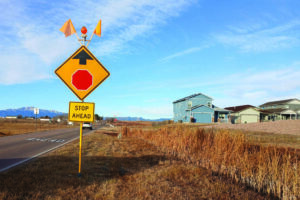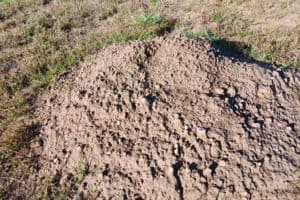Longtime local journalist Bill Radford and his wife, Margaret, live on 5 acres in the Falcon area with ducks, chickens, rabbits, dogs, cats, two noisy parrots, goats and two horses. Contact Bill at billradford3@gmail.com
I recently visited Bijou Basin, north of Peyton ñ- a broad, picturesque valley with an intriguing mix of forest and grassland, pine trees and cottonwoods.I plan to return in the summer to see Bijou Basin in what I hope will be its lush, green splendor. For now, I’ve delved into the history of the area. According to the areaís history on El Paso County’s website, Bijou Basin was once home to a settlement that predated Falcon and Peyton. A school was established there in 1874, according to the county, and the settlement also supported a blacksmith shop, a tavern and a post office. (There was a cheese factory there as well. Among the Bijou Basin tidbits reported in the May 22, 1901, Weekly Gazette was this exciting bit of news: “The Bijou Basin Cheese factory shipped a load of cheese last Friday.”) But the community was abandoned once the railroad towns around it became established, according to the county.The basin is named for Bijou Creek, which drains into the Platte River. Bijou is French for “little jewel.” But Jim Flynn, in his “A Compendium of Curious Colorado Place Names,” said the creek name likely came from a well-known French fur trapper named Joseph Bijeau, who was a guide for the 1820 expedition of Steven Long into Colorado ñ- and whose name was sometimes misspelled as Bijou.On the eastern side of the basin is Fremont’s Fort, described as “a prominent geologic formation.” I confess, though, that it didn’t stand out to me among the surrounding bluffs and mesas. Perhaps I didn’t look in the right direction, since some sources describe it as being on the basin’s south side. (So maybe southeast?) What sources do agree on is that it is named after explorer John C. Fremont. The story is that he occupied the rocky outcrop in the 1840s to avoid an attack by Indians. Historian Carl Matthews, in an article in the March 6, 1958, Douglas County News, sheds doubt on that story, calling Fremont’s Fort “the mythical site of a fight with Indians, which Fremont, never one to belittle himself, did not mention.”The May 7, 1896, issue of The Weekly Rocky Mountain News told of another intriguing formation in Bijou Basin ñ- “the breathing butte.” In the article, a “Western old-timer” tells of a cone-shaped hill with a rock at the top “in active motion, rising and falling at regular half-minute intervals.” Further exploration “found that the big stone rested upon a mass of wet and spongy matter, the pulsating force evidently coming from some powerful and deep-seated subterranean water ebb and flow.”Fremont, meanwhile, wasn’t the only notable figure to cross through Bijou Basin. Cwm Ceffyl Ranch, on the banks of West Bijou Creek, offers a history of the area on its website at http://cwmceffyl.com. Legendary frontiersman Christopher “Kit” Carson guided most of Fremont’s expeditions “and was quite familiar with the Bijou Basin,” the history states.Chief Black Kettle of the Southern Cheyenne tribe “made a practice of traveling through and possibly camping on what is now Cwm Ceffyl Ranch,” according to the website. The prominent Indian leader was a fierce advocate for peace amid waves of white settlers and broken promises by the U.S. government. He died in 1868, killed in an attack by George Armstrong Custer and his 7th Calvary.In much more recent times, Bijou Basin showed up in a place you wouldn’t expect: the pages of The New York Times. In a 2006 editorial, the Times warned against plans at the time to put a high-speed toll road ñ- nicknamed the Super Slab ó through Bijou Basin on its way from Fort Collins to Pueblo. “It doesnít have the staggering majesty of the Rocky Mountains, but it does have the delicate beauty of a rural, ranching grassland,” the editorial said of the basin.If you want to view the “delicate beauty,” the easiest way to reach Bijou Basin is to drive north on Peyton Highway from U.S. Highway 24. Be ready for a sharp right at Steeplechase Drive and continue on Peyton Highway as it becomes a dirt road.





